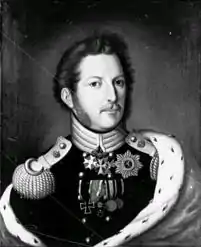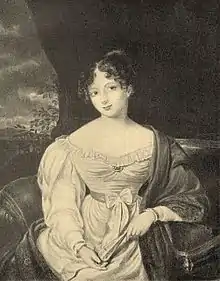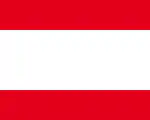William II, Elector of Hesse
William II (German: Wilhelm II; 28 July 1777 – 20 November 1847) was the penultimate Elector of Hesse.[1]
| William II | |
|---|---|
 | |
| Elector of Hesse | |
| Reign | 27 February 1821 – 20 November 1847 |
| Predecessor | William I |
| Successor | Frederick William |
| Born | 28 July 1777 Schloss Philippsruhe, Hesse |
| Died | 20 November 1847 (aged 70) Frankfurt, Hesse |
| Spouse | |
| Issue | Prince Wilhelm Princess Karoline Princess Luise Frederick William, Elector of Hesse Marie Frederica, Duchess of Saxe-Meiningen Prince Ferdinand Luise Wilhelmine Emilie Julius Wilhelm Albrecht Gustav Karl Amalie Wilhelmine Emilie Emilie Friederike Wilhelm Helene |
| House | Hesse-Kassel |
| Father | William I, Elector of Hesse |
| Mother | Wilhelmina Caroline of Denmark |
Early life
William was the eldest surviving son of William I, Elector of Hesse and Wilhelmina Caroline of Denmark and Norway. With the Hessian troops, he was involved in the War of the Sixth Coalition against Napoleon in 1813. He succeeded as Elector of Hesse (a title that was moribund after the dissolution of the Holy Roman Empire in 1806) on his father's death in 1821.
Personal life
On 13 February 1797 in Berlin, William married Princess Augusta of Prussia, fourth daughter of King Frederick William II of Prussia. They had six children:
- Wilhelm (1798–1800), who died in infancy.
- Karoline (1799–1854)
- Luise (1801–1803), who died in infancy.
- Friedrich (1802–1875), later Elector of Hesse.
- Marie Fredericka (1804–1888), who married Bernhard II, Duke of Saxe-Meiningen
- Ferdinand (1806–1806), who died in infancy.
Second marriage
William also had eight children by his second wife, Emilie Ortlöpp (1791–1843), daughter of Johann Christian Ortlöpp and wife Agnese Luise Sophie Wiessenberg, created (1821) Countess of Reichenbach-Lessonitz. The children bore the title Count/Countess of Reichenbach-Lessonitz:

| Coin of William II, Elector of Hesse, struck 1823 | |
|---|---|
 | |
| Obverse: (German) WILHELM II, KURF S.L.V. HESSEN G.H.V. FULDA, "Wilhelm II, Kurfurst und Sovereigner Landgrave von Hessen, Gross Herzog von Fulda " in English: "William II, Elector and Sovereign Landgrave of Hesse, Grand Duke of Fulda." | Reverse: (German) EINEN THALER, in English: "One Thaler." |
- Luise Wilhelmine Emilie (1813–1883), who married Karl Count von Bose.
- Julius Wilhelm Albrecht (1815–1822).
- Gustav Karl (1818–1861), who married Clementine Richter.
- Amalie Wilhelmine Emilie (1816–1858), who married Wilhelm Count von Lückner, then Karl Baron von Watzdorf.
- Emilie (1820–1891), who married Felix Count Zichy-Ferraris.
- Friederike (1821–1898), who married Wilhelm Baron von Dungern.
- Wilhelm (1824–1866), who married Helene Amelie Baroness Goeler von Ravensburg (ancestors of Ameli, Duchess of Oldenburg, Count Luitpold of Castell-Castell, and Richard, 6th Prince of Sayn-Wittgenstein-Berleburg).
- Helene (1825–1898), who married Oswald Baron von Fabrice (4x great grandparents of Princess Nikolaos of Greece and Denmark).
Third marriage
Several months after Augusta's death on 19 February 1841, William morganatically married his mistress and their children were legitimated. Emilie Ortlöpp died less than two years after the marriage in 1843.
Again, months after his second wife's death, William married (morganatically) Caroline, Baroness of Berlepsch (1820–1877), daughter of Ludwig Hermann, Baron of Berlepsch and Melusine Jul. Chr. von Kruse. William created the title of Countess of Bergen for Caroline in 1846. This marriage was childless. After his death, she married on 28 October 1851 Karl Adolf Graf von Hohenthal (1811–1875), by whom she had two sons: Karl Adolf (b. 1853) and Karl Ludwig (b. 1857).
William died on 20 November 1847 and was succeeded by his eldest surviving son, Frederick William, the last Elector of Hesse.
Descendants
Princess Tatiana of Greece and Denmark, the wife of Prince Nikolaos of Greece and Denmark, is a descendant of William II, through her mother's side.
Honours
 Electorate of Hesse:[2][3]
Electorate of Hesse:[2][3]
- Knight of the House Order of the Golden Lion, 11 May 1783;[4] Grand Cross, 29 May 1785
- Knight of the Pour la Vertu Militaire, 29 May 1785
- Knight of the Order of the Iron Helmet, 22 September 1814
 Grand Duchy of Hesse: Grand Cross of the Ludwig Order[2]
Grand Duchy of Hesse: Grand Cross of the Ludwig Order[2].svg.png.webp) Kingdom of Prussia:[2]
Kingdom of Prussia:[2]
- Knight of the Order of the Black Eagle, 26 November 1794
- Knight of the Order of the Red Eagle, 1st Class, 26 November 1794
 Kingdom of Hanover: Grand Cross of the Royal Guelphic Order, 1818[5]
Kingdom of Hanover: Grand Cross of the Royal Guelphic Order, 1818[5] Denmark: Knight of the Order of the Elephant, 16 April 1821[6]
Denmark: Knight of the Order of the Elephant, 16 April 1821[6] Austrian Empire: Grand Cross of the Order of St. Stephen, 1821[7]
Austrian Empire: Grand Cross of the Order of St. Stephen, 1821[7].svg.png.webp)
.svg.png.webp)
.svg.png.webp) Ernestine duchies: Grand Cross of the Saxe-Ernestine House Order, April 1834[8]
Ernestine duchies: Grand Cross of the Saxe-Ernestine House Order, April 1834[8]
Ancestry
| Ancestors of William II, Elector of Hesse |
|---|
Footnotes
- After 1806, the title of Elector was meaningless, since no more Holy Roman Emperors could be elected, because the Empire had been dissolved. Nevertheless, the rulers of Hesse-Kassel still used the title.
- Hessen-Kassel (1820). "Geneaologie". Handbuch des Kurhessischen Militair-, Hof- und Civil-Staats: auf das Jahr ... 1820. pp. 1–2.
- Hessen-Kassel (1820). "Ritter-orden". Handbuch des Kurhessischen Militair-, Hof- und Civil-Staats: auf das Jahr ... 1820. pp. 11, 24, 30.
- Hessen-Kassel (1784). "Ritter-orden". Hochfürstl.-Hessen-Casselischer Staats- und Adreß-Calender: 1784. Waisen- u. Findelhaus. p. 8.
- Staat Hannover (1846). Hof- und Staatshandbuch für das Königreich Hannover: 1846. Berenberg. p. 54.
- Jørgen Pedersen (2009). Riddere af Elefantordenen, 1559–2009 (in Danish). Syddansk Universitetsforlag. p. 470. ISBN 978-87-7674-434-2.
- "A Szent István Rend tagjai" Archived 22 December 2010 at the Wayback Machine
- Staatshandbücher für das Herzogtum Sachsen-Coburg und Gotha (1847), "Herzogliche Sachsen-Ernestinischer Hausorden" p. 23
Sources
- Marek, Miroslav. "Genealogy of the Hesse-Kassel line". Genealogy.EU.
External links
![]() Media related to William II, Elector of Hesse at Wikimedia Commons
Media related to William II, Elector of Hesse at Wikimedia Commons